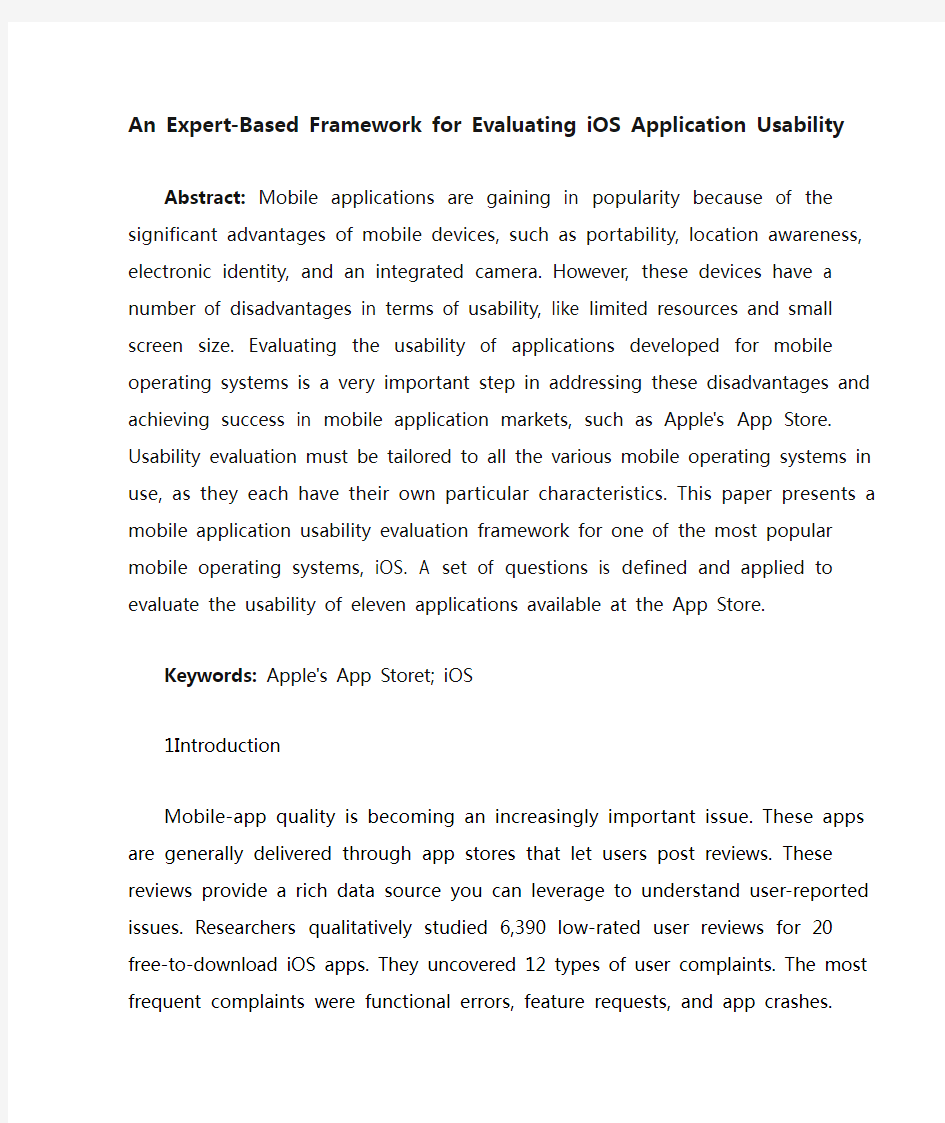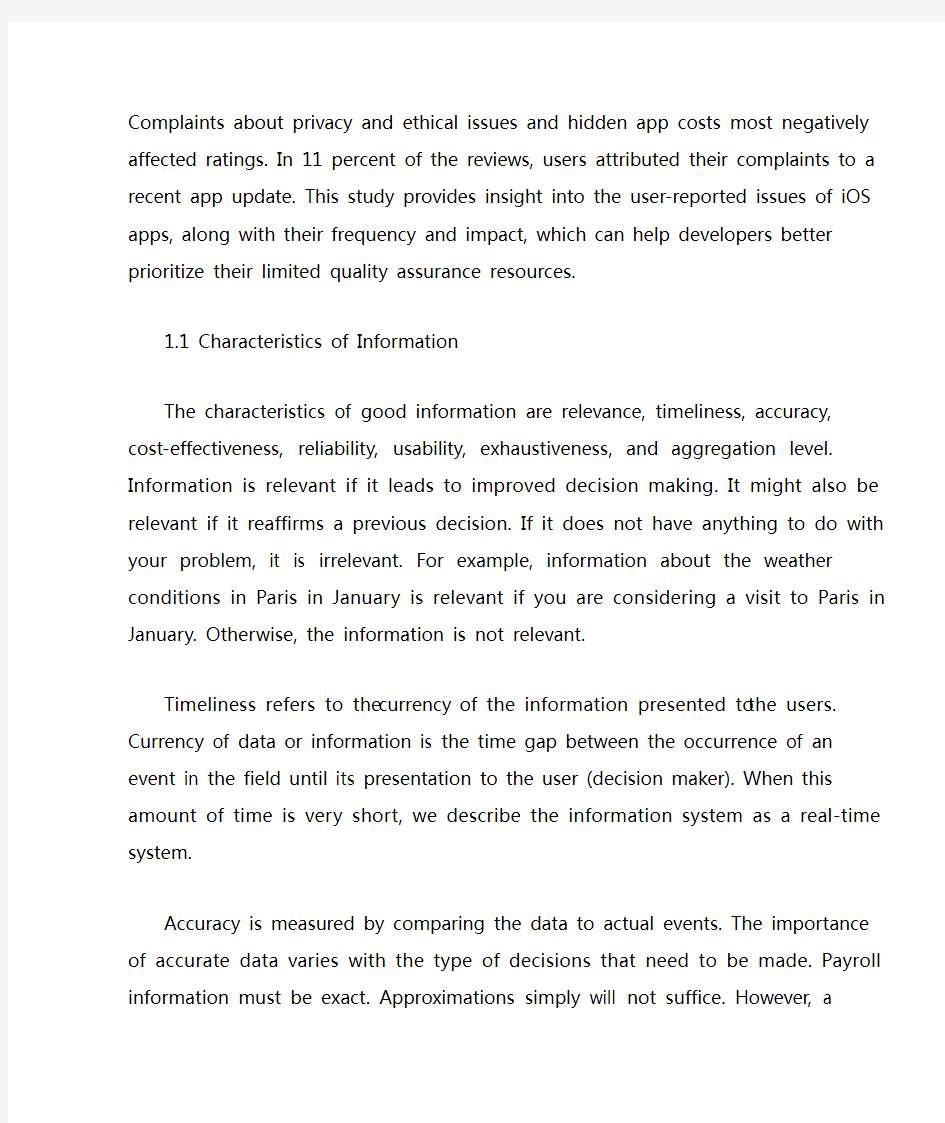

An Expert-Based Framework for Evaluating iOS
Application Usability
Abstract:Mobile applications are gaining in popularity because of the significant advantages of mobile devices, such as portability, location awareness, electronic identity, and an integrated camera. However, these devices have a number of disadvantages in terms of usability, like limited resources and small screen size. Evaluating the usability of applications developed for mobile operating systems is a very important step in addressing these disadvantages and achieving success in mobile application markets, such as Apple's App Store. Usability evaluation must be tailored to all the various mobile operating systems in use, as they each have their own particular characteristics. This paper presents a mobile application usability evaluation framework for one of the most popular mobile operating systems, iOS. A set of questions is defined and applied to evaluate the usability of eleven applications available at the App Store.
Keywords:Apple's App Storet; iOS
1Introduction
Mobile-app quality is becoming an increasingly important issue. These apps are generally delivered through app stores that let users post reviews. These reviews provide a rich data source you can leverage to understand user-reported issues. Researchers qualitatively studied 6,390 low-rated user reviews for 20 free-to-download iOS apps. They uncovered 12 types of user complaints. The most frequent complaints were functional errors, feature requests, and app crashes. Complaints about privacy and ethical issues and hidden app costs most negatively affected ratings. In 11 percent of the reviews, users attributed their complaints to a recent app update. This study provides insight into the user-reported issues of iOS apps, along with their frequency and impact, which can help developers better prioritize their limited quality assurance resources.
1.1 Characteristics of Information
The characteristics of good information are relevance, timeliness, accuracy, cost-effectiveness, reliability, usability, exhaustiveness, and aggregation level. Information is relevant if it leads to improved decision making. It might also be relevant if it reaffirms a previous decision. If it does not have anything to do with your problem, it is irrelevant. For example, information about the weather conditions in Paris in January is relevant if you are considering a visit to Paris in January. Otherwise, the information is not relevant.
Timeliness refers to the currency of the information presented to the users. Currency of data or information is the time gap between the occurrence of an event in the field until its presentation to the user (decision maker). When this amount of time is very short, we describe the information system as a real-time system.
Accuracy is measured by comparing the data to actual events. The importance of accurate data varies with the type of decisions that need to be made. Payroll information must be exact. Approximations simply will not suffice. However, a general estimate of how much staff time was devoted to a particular activity may be all that is needed.
1.2Value of Information
Information has a great impact on decision making, and hence its value is closely tied to the decisions that result from its use. Information does not have an absolute
universal value. Its value is related to those who use it, when it is used, and in what situation it is used. In this sense, information is similar to other commodities. For example, the value of a glass of water is different for someone who has lost his way in Arctic glaciers than it is to a wanderer in the Sahara Desert.
Economists distinguish value from cost or price of a commodity incurred to produce or procure the commodity. Obviously, the value of a product must be higher than its cost or price for it to be cost-effective.
The concept of normative value of information has been developed by economists and statisticians and is derived from decision theory. The basic premise of the theory is that we always have some preliminary knowledge about the occurrence of events that are relevant to our decisions. Additional information might modify our view of the occurrence probabilities and consequently change our decision and the expected payoff from the decision. The value of additional information is, hence, the difference in expected payoff obtained by reduced uncertainty about the future event. Information supports decisions, decisions trigger actions, and actions affect the achievements or performance of the organization. If we can measure the differences in performance, we can trace the impact of information, provided that the measurements are carefully performed, the relationships among variables are well defined, and possible effects of irrelevant factors are isolated. The measured difference in performance due to informational factors is called the realistic value or revealed value of information.
For most information systems, particularly those supporting middle and top management, the resulting decisions often relate to events that are not strictly defined and involve probabilities that cannot be quantified. The decision-making process often is obscure and the outcomes are scaled by multiple and incomparable dimensions. In such cases, we may either attempt to perform a multiattribute analysis or derive an overall subjective value. The subjective value reflects people's comprehensive impression of information and the amount they are willing to pay for specific information (Ahituv, Neumann, & Riley, 1994).
2 Developing mobile apps for the cognitively impaired
Declining numbers of students majoring in computer science coupled with the rapidly growing aging population are both causes for concern in society. Computer science majors have diminished since 1986, but recent thrusts of happenings focus on
encouraging students towards a STEM degree. One in every three senior citizens dies with some form of dementia with the percentages on the rise. This population is often forgotten, but research shows the elderly can be stimulated with technology as evidence with music and memory programs. Combining advancement in computer science and technology to design and develop products that can facilitate the lives of many senior citizens was found important. The combination of computer science and real-world situation is a good way to stimulate students in getting their hands on the problems our society is facing.
Programming in support of real-world social issues causes the students to relate in various ways, invigorates students not only to learn programming skills, but also acquire knowledge beyond the typical level and pace. Appealing to student interests in helping others, including possible relatives, foster experiential learning outside the classroom that potentially supports life-changing projects and assists with needs in society. In this project, students develop a mobile app for Android and iOS platforms as a team including usability for a documentary called Alive Inside, created to help those with Alzheimer's disease and dementia improve their quality of life. This mobile app will stimulate the memory of those suffering of Alzheimer and dementia through music of their youth. This paper will report on student experiences, techniques, products delivered, and overall outcomes.
3 Effectively minimizing redundant Internet streaming traffic to iOS devices
The Internet has witnessed rapidly increasing streaming traffic to various mobile devices. In this paper, we find that for the popular iOS based mobile devices, accessing popular Internet streaming services typically involves about 10% - 70% unnecessary redundant traffic. Such a practice not only overutilizes and wastes resources on the server side and the network (cellular or Internet), but also consumes additional battery power on users' mobile devices and leads to possible monetary cost. To alleviate such a situation without changing the server side or the iOS, we design
and implement a CStreamer prototype that can transparently work between existing iOS devices and media servers. We also build a CStreamer iOS App to enable end users to access Internet streaming services via CStreamer. Experiments conducted based on this prototype running on Amazon EC2 show that CStreamer can completely eliminate the redundant traffic without degrading user's QoS.
There are many existing software applications that claim to teach English literacy. However, these applications often cater to preschoolers, only teach vocabulary or phonetics and mostly focus on fundamental reading skills, and not comprehension. This project aims to develop an application that teaches 7-10 years old children comprehension of the English language. Research was conducted into existing applications and pedagogy leading to the elicitation of requirements specification and design. Our iOS app is designed as a tailored cloze activity ("fill-in-the-blanks") in the context of a story. A usability study was conducted with 18 children in the target age group at two primary schools from different socio-economic areas. Overall response to the application was positive with high intuitiveness and engagement ratings. Future work includes refinements and can explore effectiveness of the app through a longer case study.
The popularity of mobile application platforms like IOS, Android or Windows Phone 7 increases from day to day. Affiliated app stores offer thousands of different applications (so called apps) for nearly any imaginable purpose. From a software developer's point of view these app stores provide high potential: developers have the chance to reach the general public, thus having a much broader audience than with any other channel of distribution. Nevertheless, the increased amount of potential customers also increases expectations related to user experience. The user interface as the main interaction hub in mobile environments attracts a lot more attention. The success or failure of an app is often related to its user interface. Furthermore, users often demand the same user experience on different platforms. In order to allow for high quality in user interface development and to enable development for different platforms, a framework is presented that provides a platform independent definition of a user interface backed by constraints in form of rules. Using model driven development, the framework allows the creation of user interfaces that are not related to a specific target technology. Furthermore, it provides the ability to define a user interface and transform it into a destination user interface, whether this will be Android, iPhone or Windows Phone 7, with respect to given rules.
4 Conclusion
The importance of inter-organizational system (iOS) has been increasingly recognized by organizations and it is becoming vital and a competitive necessity due to globalization and the growing importance of business alliances, because organizations are interdependent for survival. Based upon intensive review of iOS development literature, special factors are influential in developing inter-organizational information systems that are different from factors in developing intra-organizational information systems. In this paper, all factors comprehensively have been identified and analyzed by using a system approach. Obtained findings suggested that there are six groups of factors that significantly affect on IOS development. Then significance and priority of the each factor by Shannon entropy were determined. Result of this research exhibit that relationship type between organizations is most important factor in iOS developing while in past researches less attention has been to iOS stakeholders.